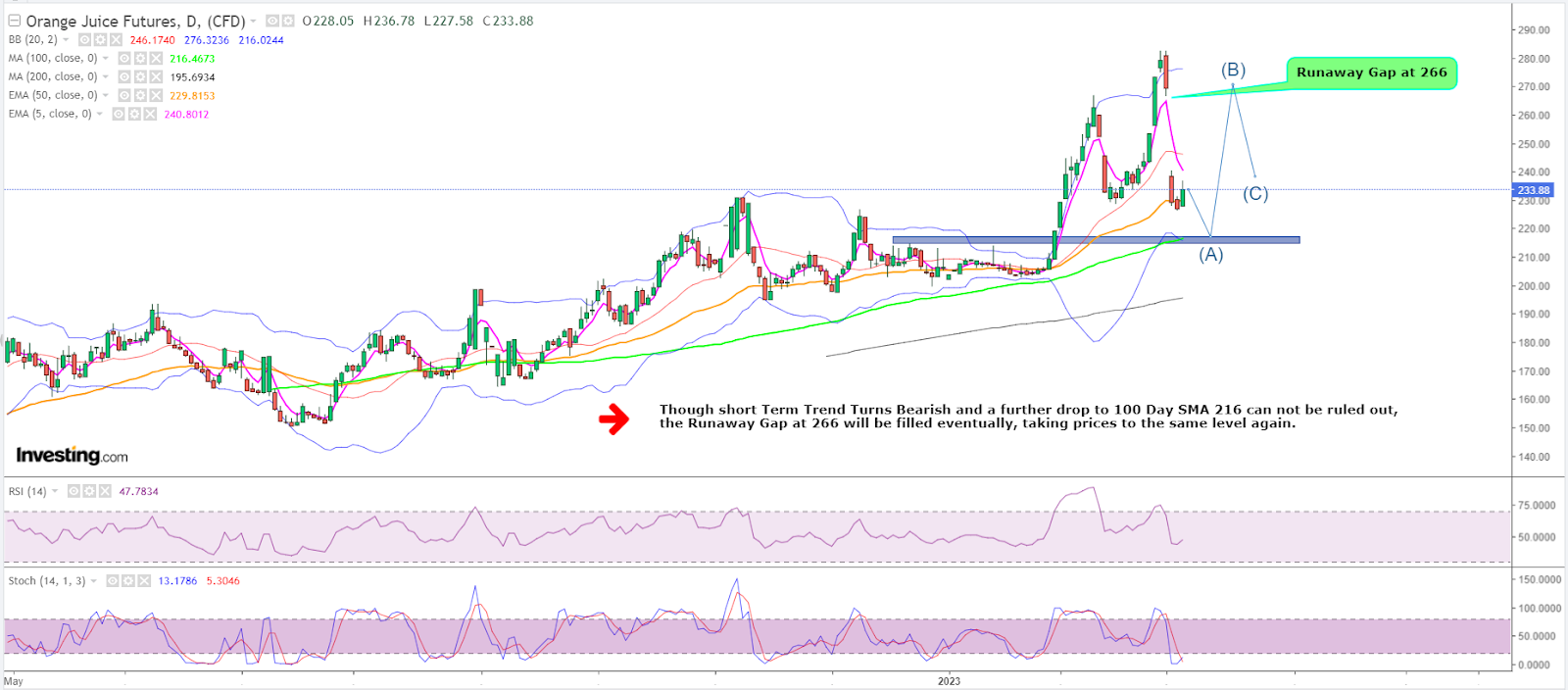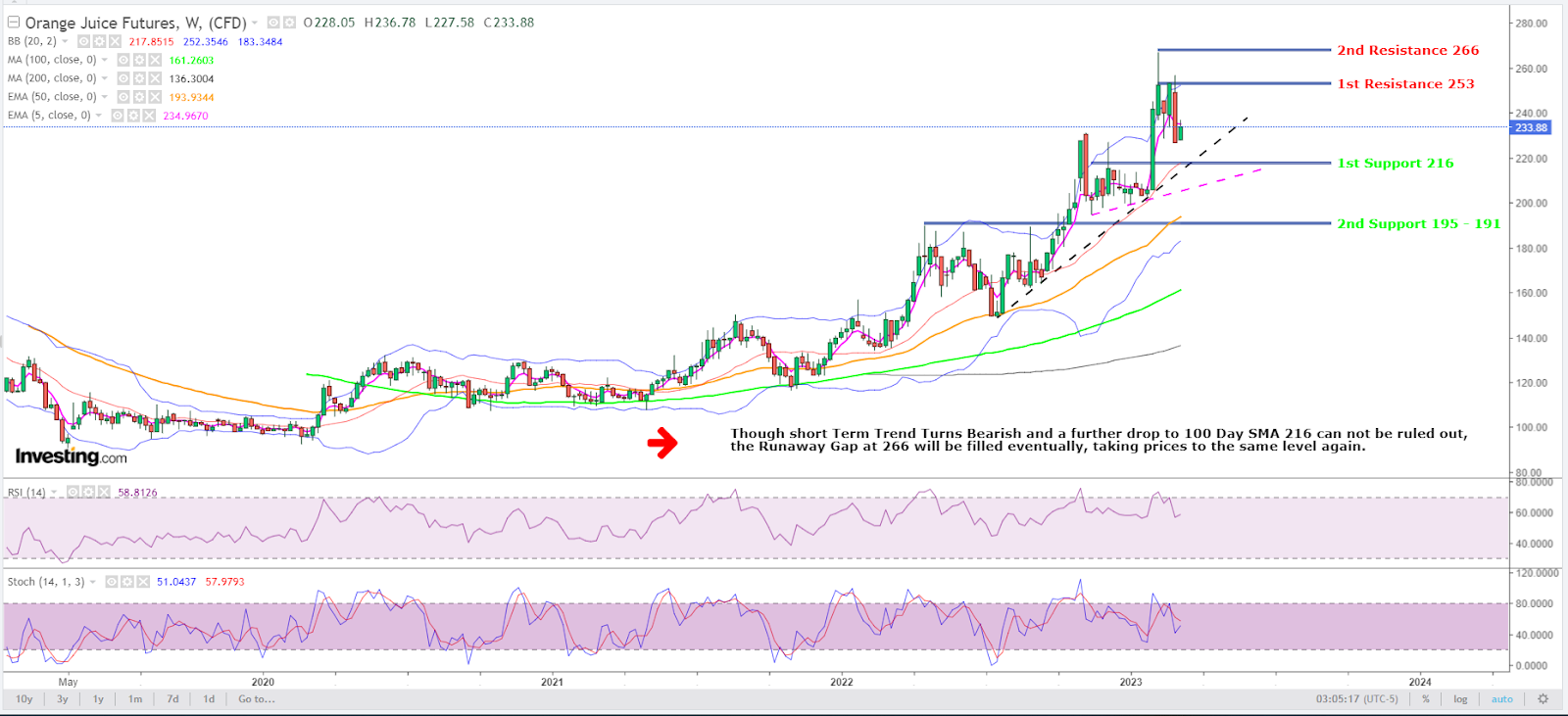Street Calls of the Week
- Juice futures down 17% since hitting record high of $2.8250
- Low thus far thus has been five-week bottom of $2.2650
- Charts suggest a slight rebound, then further drop to beneath $2
- Selloff driven mainly by improving Florida to Brazil crop conditions
A month ago, I said $3 a lb could do a lot of damage to orange juice futures. Well, America’s citrusy favorite didn’t exactly get there, but it went close enough and has been crashing since, as the harsh crop conditions that took it to a record high turn benign.
Frozen concentrated orange juice futures — which determines shelf prices for the beverage — settled at $2.3685 a lb on New York’s InterContinental Exchange on Monday. That was down 46.65 cents, or 17%, from the record high of $2.8250 reached four sessions earlier.
And things could get worse for FCOJ, as it’s known by its acronym, based on chart readings.
Charts by SKCharting.com, with data powered by Investing.com
The short term trend in FCOJ has turned bearish after its steep, near-55 cent fall from record highs above $2.80, said Sunil Kumar Dixit, chief technical strategist at SKCharting.com.
A further decline toward the 100-Day SMA, or Simple Moving Average, of $2.16 could hardly be ruled out, with the next major test after that being sub $2, said Dixit.
Meanwhile, Daily Stochastics were beginning to make positive overlap, signaling some exhaustion in bearish pressure, he said.
“We must be mindful of the runaway gap left at 266 that will have to be filled in eventually, taking OJ futures back to the same heights again at some point of time. Mid-term perspective suggests an upward rebound, for a retest of the $2.53 and $2.66 resistance, and a follow-through continuation of correction towards $2.16 and $1.95.”

Chart action is just one thing that’s driving the selling in orange juice.
The bigger thing is, of course, fundamentals driven by improving crop conditions in top U.S. orange grower Florida to Brazil, the world’s number one citrus producer.
Jack Scoville, chief crop analyst at Chicago’s Price Futures Group brokerage, noted that while FCOJ hit record highs back-to-back on Feb. 28 and March 1, it also hit a five-week low of $2.2650 by March 3 in what he described as “a wild week of trading”.
“Production remains the overriding force. Historically low estimates of production due in part to the hurricanes and in part to the greening disease that have hurt production, but conditions are significantly better now with scattered showers and moderate temperatures.
The weather remains generally good for production around the world for the next crop including production areas in Florida that have been impacted in a big way by the two storms seen previously in the state.”
As for Brazil, it has some rain and crop conditions were generally rated “good”, Scoville said, adding:
“Brazil continues to export to the EU and is increasing its exports to the US. Mexico is also exporting to the US. The Florida Dept of Citrus reported that inventories are still 40.0% below last year.”
The record high in FCOJ had been coming for a while. Two back-to-back hurricanes last year devastated the crop, while frost from each cold season retards fruit growth. Besides these, a tough-to-fight plant disease called “citrus greening” along with aggressive residential development have swallowed acres and acres of groves in top orange-growing state Florida.
Notwithstanding the latest slump, orange juice futures are still up 27 cents, or 13%, on the year. Compared with a year ago, FCOJ is up 55%, when it traded at around $1.52 per pound.
Orange juice became the world's favorite fruit drink and a commodity due to processing, freezing, and flavoring agents. While there are other orange juice products, FCOJ is the asset used to benchmark orange juice pricing and is also the most widely traded.
But Florida’s orange production is in a dire state now, having plummeted more than 90% from the peak of the late 1990s. As supply falls and prices rise, demand for orange juice will likely also take a hit, as consumers tend to be less willing to shell out the big bucks for the citrusy beverage than say, coffee.
Forecasters at the USDA estimated that this year's orange crop will fall to its lowest level since the 1930s, after Hurricane Ian dealt extensive damage to orange groves across Florida last year followed by Hurricane Nicole. Florida’s farmers were still recovering from the devastation wrought by Hurricane Irma in 2017, before the latest storms struck.
According to the USDA, Florida orange production will slump 61% in 2023 to 16 million boxes. The total U.S. orange harvest is expected to fall 23% to 63 million boxes. The boxes can vary in weight but are typically measured as 90 pounds to one box. In 1998, Florida produced as many as 244 million boxes.
U.S. consumption of juice has already fallen exponentially over the past two decades after doubling from 800 million gallons in 1970 to 1.6 billion in 2000. In 2019, per capita juice consumption was at 2.25 gallons, down 40% from 2010. But in the mind of the average American, orange juice is still a breakfast drink that’s on almost every table — a myth that hasn’t helped nurture enough concern for the embattled industry in Florida.
The only thing that has kept U.S. orange juice production — and prices — constant are imports from Brazil.
Compared with the crop decimation in Florida, Brazilian FCOJ production is forecast to drop only 1% from the prior year to reach 1.12 million metric tons in 2022–23.
Disclaimer: Barani Krishnan uses a range of views outside his own to bring diversity to his analysis of any market. For neutrality, he sometimes presents contrarian views and market variables. He does not hold positions in the commodities and securities he writes about.
